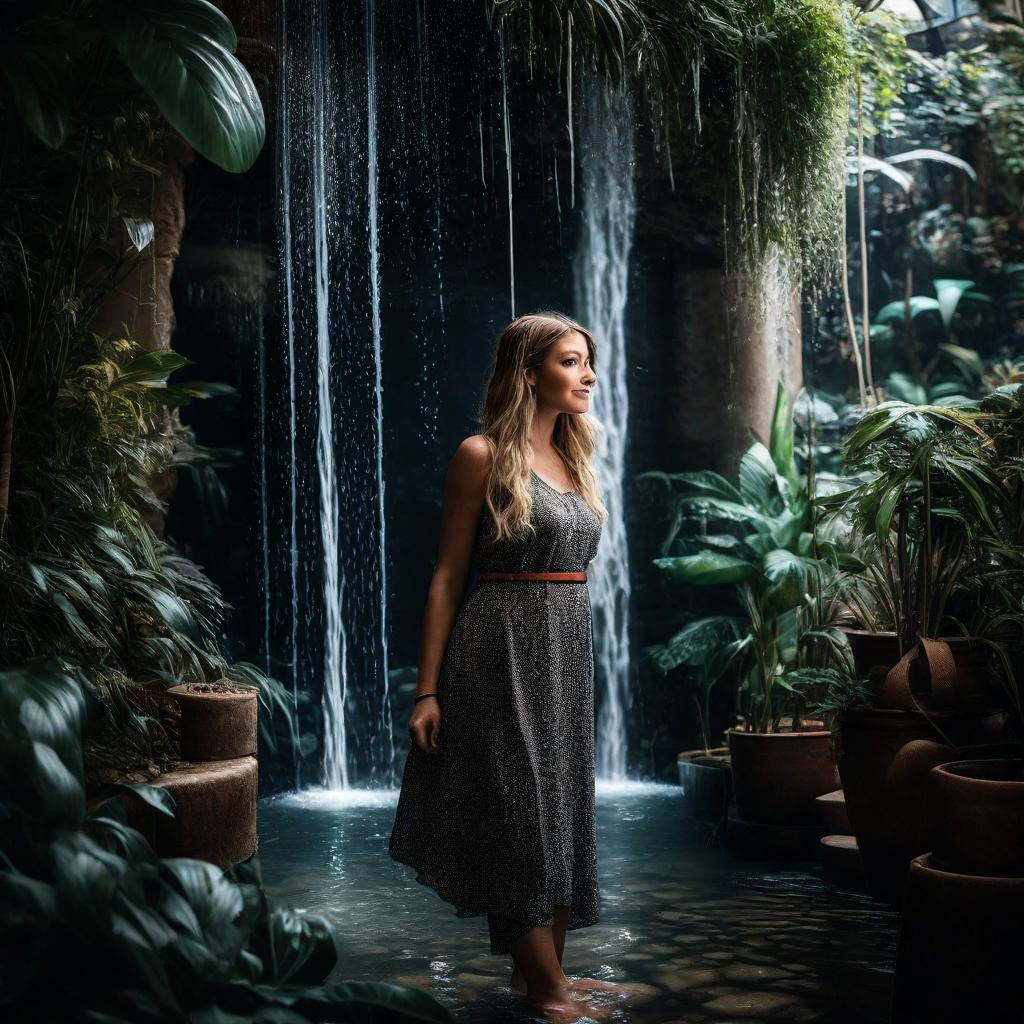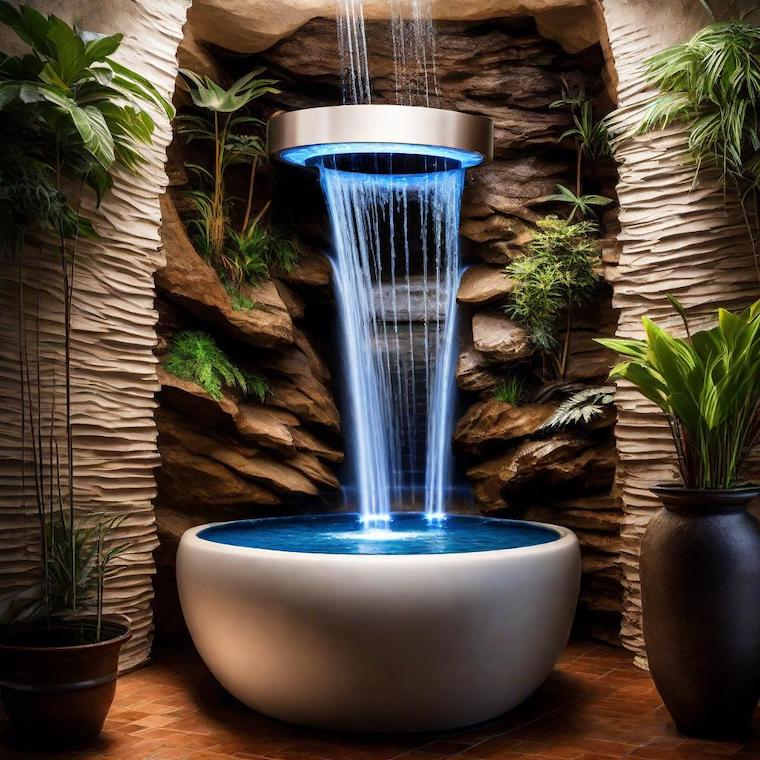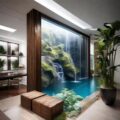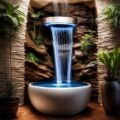Indoor Waterfall Fountain has emerged as a captivating addition to interior spaces, seamlessly blending aesthetics with tranquility. A symphony of cascading water not only serves as a visual delight but also introduces an element of serenity to any room. Here we’ll provide a glimpse into the enchanting world of Indoor Waterfall Fountains, delving into their design, functionality, and the transformative ambiance they bring to homes and workplaces alike.
Overview
Indoor Waterfall Fountains, often crafted with precision and artistic flair, are captivating fixtures designed to recreate the soothing sounds and mesmerizing sights of cascading water within the confines of your living or working space. These fountains come in various sizes, styles, and materials, catering to diverse preferences and interior designs. From contemporary to classical, Indoor Waterfall Fountains offer a versatile range to complement any aesthetic.
Benefits of Adding an Indoor Waterfall Fountain to Your Space
Calming Atmosphere: The gentle flow of water induces a sense of calm and relaxation, making Indoor Waterfall Fountains ideal for stress relief and creating peaceful environments.
Aesthetic Appeal: These fountains serve as striking focal points, enhancing the visual appeal of any room and adding a touch of sophistication to the overall decor.
Improved Air Quality: As water cascades, it helps to humidify the air, contributing to better air quality by reducing dust particles and promoting a healthier living environment.
Positive Feng Shui: Indoor Waterfall Fountains are believed to bring positive energy and balance to spaces, aligning with the principles of Feng Shui for overall well-being.
Choosing the Right Indoor Waterfall Fountain
A. Size and Space Considerations
Matching Fountain Size to Room Dimensions:
Selecting the appropriate size for your Indoor Waterfall Fountain is crucial for achieving a harmonious balance within your space. Consider the dimensions of the room where the fountain will be placed, ensuring that it neither overwhelms the area nor appears too diminutive.
Placement Options for Optimal Impact:
Once you’ve determined the suitable size, the next step is to explore various placement options that will maximize the visual impact of your Indoor Waterfall Fountain. Whether it’s a central focal point or a subtle corner installation, understanding the potential placements and their effects on the overall atmosphere will help you make an informed decision.
B. Style and Design
Exploring Different Fountain Styles
Indoor Waterfall Fountains come in a diverse collection of styles, each with its own unique charm. You can go for popular fountain styles such as wall-mounted, freestanding, tabletop, and custom-built designs. By understanding the characteristics of each style, you’ll be better equipped to choose a fountain that aligns with your personal taste and complements the overall theme of your interior space.
Complementing Your Interior Décor
Harmonizing your Indoor Waterfall Fountain with existing interior decor is key to achieving a cohesive and visually appealing environment. Explore tips and suggestions for choosing a fountain that complements your color palette, furniture, and overall design scheme. Whether your space leans towards modern minimalism or classic elegance, finding the right design synergy will enhance the aesthetic appeal of both the fountain and the surrounding area.
C. Material Selection
Popular Fountain Materials and Their Characteristics
Indoor Waterfall Fountains are crafted from a variety of materials, each with its unique qualities. Look over the popular materials such as glass, slate, stainless steel, and resin, outlining their aesthetic appeal, durability, and maintenance requirements. Understanding the characteristics of these materials will empower you to make an informed decision based on your preferences and lifestyle.
Durability and Maintenance Considerations
Beyond aesthetics, the durability and maintenance aspects of your chosen material are crucial for long-term satisfaction. Learn about the resilience of different materials to water exposure, ease of cleaning, and resistance to wear and tear. Armed with this knowledge, you can select a material that aligns with your maintenance preferences and ensures the longevity of your Indoor Waterfall Fountain.
Installation Process
A. Preparing Your Space
Assessing Electrical Outlets and Water Sources
Before embarking on the installation of your Indoor Waterfall Fountain, a thorough assessment of electrical outlets and water sources is essential. Understand the process of identifying accessible electrical outlets and ensuring proximity to a water source, facilitating a seamless and convenient installation. Understanding the placement of these essential resources will contribute to a safer and more efficient setup.
Ensuring Proper Flooring and Surface Protection
Protecting your flooring and surrounding surfaces is crucial to prevent water damage and maintain the integrity of your indoor space. Explore recommendations for suitable flooring types and additional protective measures, such as waterproof mats or trays, to safeguard against potential leaks or spills. This step ensures a worry-free installation process and preserves the longevity of both your fountain and your indoor environment.
B. Step-by-Step Installation Guide
Assembling the Fountain Components
A systematic assembly of your Indoor Waterfall Fountain components is the first step towards bringing your vision to life. Understand, step-by-step guide on assembling the fountain, including aligning panels, securing structural elements, and integrating any additional features. Clear instructions and visual aids will aid in a smooth assembly process, even for those with minimal DIY experience.
Connecting Electrical and Water Supply
The proper connection of electrical and water components is critical to the functionality and safety of your Indoor Waterfall Fountain. This part of the guide will walk you through the intricacies of connecting the pump, lights, and any other electrical features. Also, it will cover the installation of water supply lines, ensuring a secure and efficient circulation system. Understanding these connections is key to maintaining the optimal performance of your fountain.
Testing and Troubleshooting Tips
Once the installation is complete, thorough testing is imperative to identify and address any potential issues. Prepare a checklist for testing the fountain’s water flow, lighting, and overall functionality. Also, troubleshooting tips will be included to guide you in resolving common issues swiftly. By conducting comprehensive tests and being equipped with troubleshooting know-how, you can ensure a successful installation and immediate enjoyment of your Indoor Waterfall Fountain.
Maintenance and Care
A. Regular Cleaning and Water Treatment
Cleaning Frequency and Methods
Maintaining the pristine condition of your Indoor Waterfall Fountain involves regular cleaning to prevent the buildup of algae, debris, and other contaminants. Use, the recommended cleaning frequency based on factors such as fountain size and location. Also, it will provide step-by-step cleaning methods, covering the removal of impurities from different fountain components. Establishing a routine for cleaning ensures a consistently clear and appealing water feature.
Choosing the Right Water Treatment Products
Water treatment is essential for sustaining the clarity and quality of your Indoor Waterfall Fountain. Explore various water treatment products, including algaecides and water clarifiers, and understand their specific roles in maintaining a healthy water environment. Go for selecting the right products for your fountain, considering factors such as water hardness and the prevention of bacterial growth. Implementing proper water treatment practices contributes to the longevity of your fountain and the well-being of its components.
B. Troubleshooting Common Issues
Addressing Pump and Motor Concerns
Fountains rely on pumps and motors for proper water circulation and overall functionality. This part of the guide will cover troubleshooting steps for common issues such as pump malfunctions, irregular water flow, or unusual noises. Learn how to inspect, clean, and potentially replace fountain pumps or motors to ensure the continuous operation of your Indoor Waterfall Fountain. Proactive troubleshooting measures will help identify and resolve problems before they escalate.
Dealing with Scaling and Mineral Deposits
Over time, mineral deposits and scaling can accumulate on the surfaces of your Indoor Waterfall Fountain, affecting its appearance and functionality. From descaling agents to DIY cleaning solutions, you’ll discover strategies to combat scaling and maintain the aesthetic appeal of your fountain. Understanding how to address scaling issues will contribute to the longevity of your fountain’s components and the sustained beauty of your indoor space.
Frequently Asked Questions
Consider the dimensions of your room and choose a fountain size that complements the space without overwhelming it.
Explore central focal points, corner installations, or wall placements to find the optimal spot for maximizing visual impact.
Learn about materials such as glass, slate, stainless steel, and resin, and understand their characteristics in terms of durability and aesthetics.
Understand the importance of proximity to electrical outlets and water sources to ensure a convenient and safe installation process.
Explore recommendations for suitable flooring types and additional protective measures, such as waterproof mats or trays.

With a deep appreciation for the soothing allure of indoor water features, i share expertise in crafting, maintaining, and personalizing waterfalls for homes and spaces. Join the journey to transform spaces into serene havens.






Leave a Reply